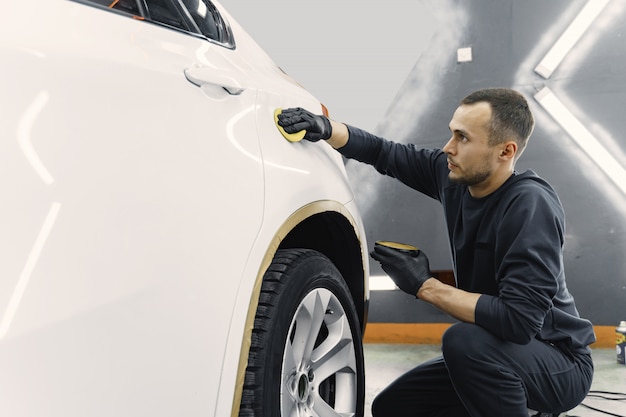Applying Ceramic Coating: How It’s Done

Quick Summary
Ceramic coating is a popular choice for car enthusiasts looking to protect and enhance the appearance of their vehicles. This article explains the process of applying ceramic coating, starting with a basic understanding of what it is and its benefits, such as enhanced protection, hydrophobic properties, longevity, and ease of maintenance. The application process involves thorough surface preparation, panel-by-panel application, buffing and leveling, and a final inspection to ensure even coverage. Curing time is crucial, and post-application care is necessary for maintaining the coating’s benefits. Ultimately, ceramic coating is an investment in preserving your car’s beauty and value.
When it comes to protecting your vehicle’s paint and maintaining its glossy appearance, ceramic coating has become a popular choice among car enthusiasts. This advanced technology offers superior protection and durability compared to traditional wax or sealants. In this article, we will delve into the process of applying ceramic coating and understand how it’s done.
Understanding Ceramic Coating
Before we dive into the application process, it’s crucial to have a basic understanding of what ceramic coating is and what it offers. Ceramic coating, also known as nano-ceramic coating, is a liquid polymer applied to the exterior surfaces of a vehicle. Once cured, it forms a transparent, protective layer that bonds with the factory paint, creating a hydrophobic and highly durable shield.
The Benefits of Ceramic Coating
Before applying ceramic coating, it’s essential to recognize the advantages it brings to the table. Here are some key benefits:
- Enhanced Protection: Ceramic coating provides exceptional protection against various environmental contaminants, including UV rays, acid rain, bird droppings, and tree sap.
- Hydrophobic Properties: The hydrophobic nature of ceramic coatings repels water and prevents water spots, making it easier to clean and maintain your vehicle.
- Longevity: Unlike traditional wax or sealants, ceramic coatings can last for several years, reducing the need for frequent reapplications.
- Enhanced Gloss: It enhances your car’s appearance by giving it a deep, glossy shine that lasts.
- Ease of Maintenance: Cleaning your car becomes a breeze with ceramic coating, as dirt and grime don’t adhere to the surface easily.
The Application Process
Now, let’s get into the nitty-gritty of how ceramic coating is applied:
- Surface Preparation:
- Thoroughly wash and decontaminate your vehicle’s exterior.
- Clay bar the paint to remove any embedded contaminants.
- If necessary, polish the paint to remove minor imperfections and enhance the surface’s smoothness.
- Panel by Panel Application:
- Ceramic coating should be applied one panel at a time. Start with a small section to ensure even coverage and prevent the coating from drying prematurely.
- Apply a few drops of the ceramic coating product onto an applicator pad. Use a quality microfiber applicator or sponge.
- Spread the product evenly in straight lines, ensuring full coverage without streaks.
- Allow the coating to sit for a specific time, known as the “flash” or “cure” time. This varies depending on the product you’re using, so follow the manufacturer’s recommendations.
- Buffing and Leveling:
- After the flash time, use a clean, dry microfiber towel to gently buff the applied area. This helps level the coating and remove any excess product.
- Ensure thorough and even coverage, as any missed spots may result in inconsistent protection.
- Repeat for Each Panel:
- Continue the process panel by panel until you’ve covered the entire vehicle. Work systematically to maintain a consistent application.
- Final Inspection:
- Once you’ve applied ceramic coating to all panels, carefully inspect the vehicle’s surface to ensure uniform coverage and a streak-free finish.
- Any high spots or uneven areas should be corrected immediately using the same coating product and applicator.
- Curing Time:
- After completing the application, the ceramic coating needs time to cure. This typically takes anywhere from 24 to 48 hours, depending on the product and environmental conditions.
- During this curing period, avoid exposing the vehicle to rain, moisture, or physical contact.
- Post-Application Care:
- After the coating has fully cured, you can enjoy the benefits of ceramic coating. Regular maintenance involves gentle washing and occasional top-ups with a ceramic spray or booster product.
Conclusion
Applying a ceramic coating to your vehicle is a meticulous process that requires careful attention to detail. However, the benefits it offers in terms of long-lasting protection and a stunning finish make it well worth the effort. Whether you choose to apply it yourself or seek professional assistance, ceramic coating is an excellent investment in preserving the beauty and value of your car.








